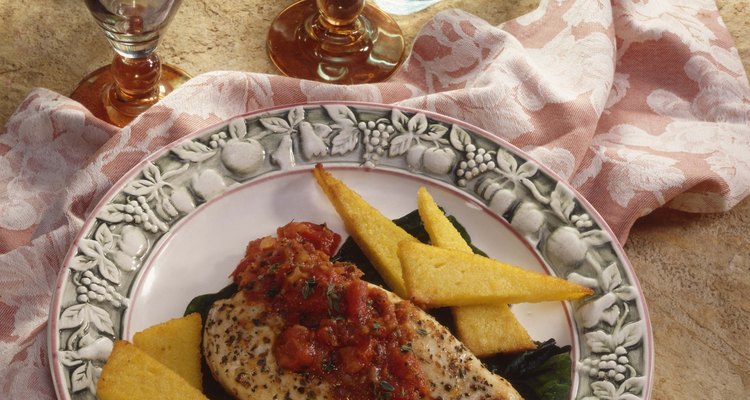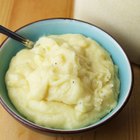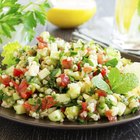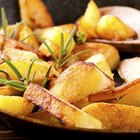
Polenta, along with pasta and risotto, is one of the three basic starchy dishes that characterize Italian cuisine. Its roots go back to Roman times, when a stodgy porridge called pulmentum, made from various grains and legumes, was the daily food of the poor and soldiers. Modern-day polenta is made from corn.
Polenta
Polenta is a thick porridge made from cornmeal and served as a side dish at meals. Traditionally, most Italians made it with a special coarse grind of cornmeal, also called "polenta" in the American market. It was slow-cooked for hours in the ashes of a farmhouse hearth, until it became soft and smooth. Today, in Italy as elsewhere, few people have time to cook things the old-fashioned way. Italian stores carry electric polenta makers, which stir the pot of corn continually as it cooks, and precooked instant polenta is also a common convenience food in modern Italy.
Substituting "Polenta," the Grain
In this country, the term "polenta" is applied both to the finished product and to the uniquely coarse cornmeal used to make it. The latter can be difficult to find if you live in an area without a significant Italian-American presence or prefer not to order from the Internet. Use the cornmeal you have and serve it unapologetically. Don't worry about authenticity, because finer cornmeal is used in many parts of Italy. In the northeastern region around Udine, they even favor finely-ground white cornmeal.
Semolina
If you want to make polenta that's corn free, the best option is coarse semolina. Made from the same hard wheat as pasta, semolina cooks in exactly the same way as cornmeal. You can serve it hot, like conventional polenta, or allow it to cool and then slice it. Polenta made from semolina lacks the sunny yellow hue of the traditional version, but you can use the paleness to your advantage by combining it with richly colored sauces and bright garnishes.
Other Polenta Substitutes
You can use various other grains to make polenta-like side dishes, if they are milled to a similar size and texture. Buckwheat groats, bulgur wheat and cracked barley are all suitable candidates for this cooking method. Buckwheat and bulgur have strong flavors of their own, so you'll need to carefully consider which meals you pair them with. Barley presents the opposite problem, being rather bland. Dress it up with fresh herbs or strong cheese for the best results.
Related Articles
Are Masa & Fine Cornmeal Used for ...

How to Make Cornmeal Polenta

How to Cook Bulgur Without Getting Mushy

How to Make a Male Medieval Peasant ...

What Foods Do People in Ireland Eat?
How to Cook Grits in the Microwave

What Are Some Examples of Unleavened ...

Is Corn Flour Considered Whole Grain?

What Are Hominy & Grits?

Facts About Sombreros
Is Unbleached Flour the Same as ...

How to Cook With Kamut

Quaker Oats Instant Grits: Nutritional ...

What Are Yellow Grits?

Can I Substitute Mustard for Moutarde ...

What Kind of Bread Do I Serve With ...

How Long Do I Cook Vermicelli?

How to Replace Wheat

How to Cook Orecchiette

Directions on How to Cook Soba Noodles
References
- "On Food and Cooking: The Science and Lore of the Kitchen"; Harold S. McGee; 2004
- "La Cucina di Lidia"; Lidia Bastianich; 1990
- "Heat: An Amateur's Adventures as Kitchen Slave, Line Cook, Pasta-Maker, and Apprentice to a Dante-Quoting Butcher in Tuscany"; Bill Buford; 2006
- Life in Italy; Polenta: Italy's Other National Dish; Justin Demetri
Writer Bio
Fred Decker is a trained chef and prolific freelance writer. In previous careers, he sold insurance and mutual funds, and was a longtime retailer. He was educated at Memorial University of Newfoundland and the Northern Alberta Institute of Technology. His articles have appeared on numerous home and garden sites including GoneOutdoors, TheNest and eHow.
Photo Credits
Jupiterimages/Comstock/Getty Images